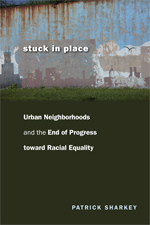Are poor families stuck in place?
A few weeks ago, I wrote a review of a new book by the Brookings Institute called Confronting Suburban Poverty that highlights the growing number of poor people living in suburbs and small cities across America.  While I have some strong concerns about the book, it does draw needed attention to the changing demographics of poverty in America. Interestingly, when I bought the Brookings book on-line, Amazon.com kindly recommended that I buy another new book that highlights the persistent and long standing problem of concentrated poverty in the inner city. This book, Stuck in Place: Urban Neighborhoods and the End of Progress toward Racial Equality, by Patrick Sharkey, provides new insights into this old problem.
While I have some strong concerns about the book, it does draw needed attention to the changing demographics of poverty in America. Interestingly, when I bought the Brookings book on-line, Amazon.com kindly recommended that I buy another new book that highlights the persistent and long standing problem of concentrated poverty in the inner city. This book, Stuck in Place: Urban Neighborhoods and the End of Progress toward Racial Equality, by Patrick Sharkey, provides new insights into this old problem.
Drawing on detailed, longitudinal data about white and African American families over the past several decades (comprehensive and long term data does not exist for more recent immigrant groups), Sharkey documents that the negative impacts of concentrated poverty deepen as successive generations of the same family live in poor neighborhoods, especially for African American families. Some of Sharkey’s key findings:
- Disadvantage can be inherited just like wealth can be. Says Sharkey, “to understand neighborhood inequality we must think in terms of generations not single points of time or even single periods in an individual’s life.”
- Neighborhoods clearly account for some, but by no means all, of the social and economic disparities that exist between African Americans and whites.
- African Americans not only have less upward mobility than whites, but they have significantly higher rates of downward mobility. In other words, those African Americans who do attain middle class status are often unable to sustain it over time as they are “caught between two worlds, one dominated by the ideals of education and advancement up the income ladder, the other dominated by the presence of gang activity, poorly functioning schools and violence.” Moreover, the social and family connections that can be a source of support for some African Americans can pull others downward.
- There is strong evidence that when neighborhoods do improve “the economic fortunes of black youth improve and improve rather substantially.”
- The “most common pattern of neighborhood ‘improvement’ for African Americans in the 1980s entailed improvement in the economic status of residents combined with ethnic diversification in the form of a rise in Latino and foreign born newcomers.” This is very different than the “common conception of gentrification which often connotes a racial turnover where new white entrants …displace original minority residents,” writes Starkey.
- Mobility programs that help families leave low income neighborhoods have shown mixed results with the most significant impacts on families who left the most devastated neighborhoods and moved to suburbs outside the central city. Less dramatic changes in neighborhoods generated less clear results.
Based on these findings, Sharkey has important policy recommendations to offer:
Programs that work only at the neighborhood level can be overwhelmed by larger economic forces, but efforts to focus on regional and national economic strategies often leave challenged neighborhoods behind. Therefore, he concludes, we need to have policies working at all of these levels at the same time.
- Given the generational nature of the problem, we need a “durable” set of policies that are sustained over time, unlike the War on Poverty programs that were quickly abandoned or scaled back after a few years. There is no quick fix to these long standing problems.
- Mobility programs have a role to play, but they cannot be taken to scale, almost by definition. We can’t move everyone out of the inner city and if we were to move a significant number of people they are likely to end up in newly concentrated areas of poverty – assuming we could find the housing and the political support needed for such a policy. (He does not mention, but I will, the problem of what happens to the people left behind in poor neighborhoods if mobility programs were to scale up and depopulate these places.)
- Placed based programs that work to comprehensively improve poor neighborhoods are essential and need to be sustained over time.
- “One of the most formidable challenges to maintaining cohesive urban communities in the years and decades to come will be dealing with the destabilizing consequences of mass imprisonment.”
- Sharkey offers a resounding endorsement of CDCs. He writes that “local community organizations focusing on housing and physical development, economic development, asset building, and resident organization must continue to be supported, as these types of organizations provide a stabilizing force in city neighborhoods, even in the most challenging economic and political climates.”
While the problems detailed in the book can be overwhelming, it was refreshing to read such a detailed and honest account of the challenges we face and such a balanced and thoughtful approach to the policies we need. He recognizes the need for many different strategies, emphasizes the long term nature of this work, and cautions against policies that look for a quick fix. With all of this, Starkey remains hopeful as there is significant evidence that we can make progress if we as a society are prepared to make a deep and durable commitment to doing so.
For those who want to see our country make that commitment, Sharkey’s book is essential reading.









